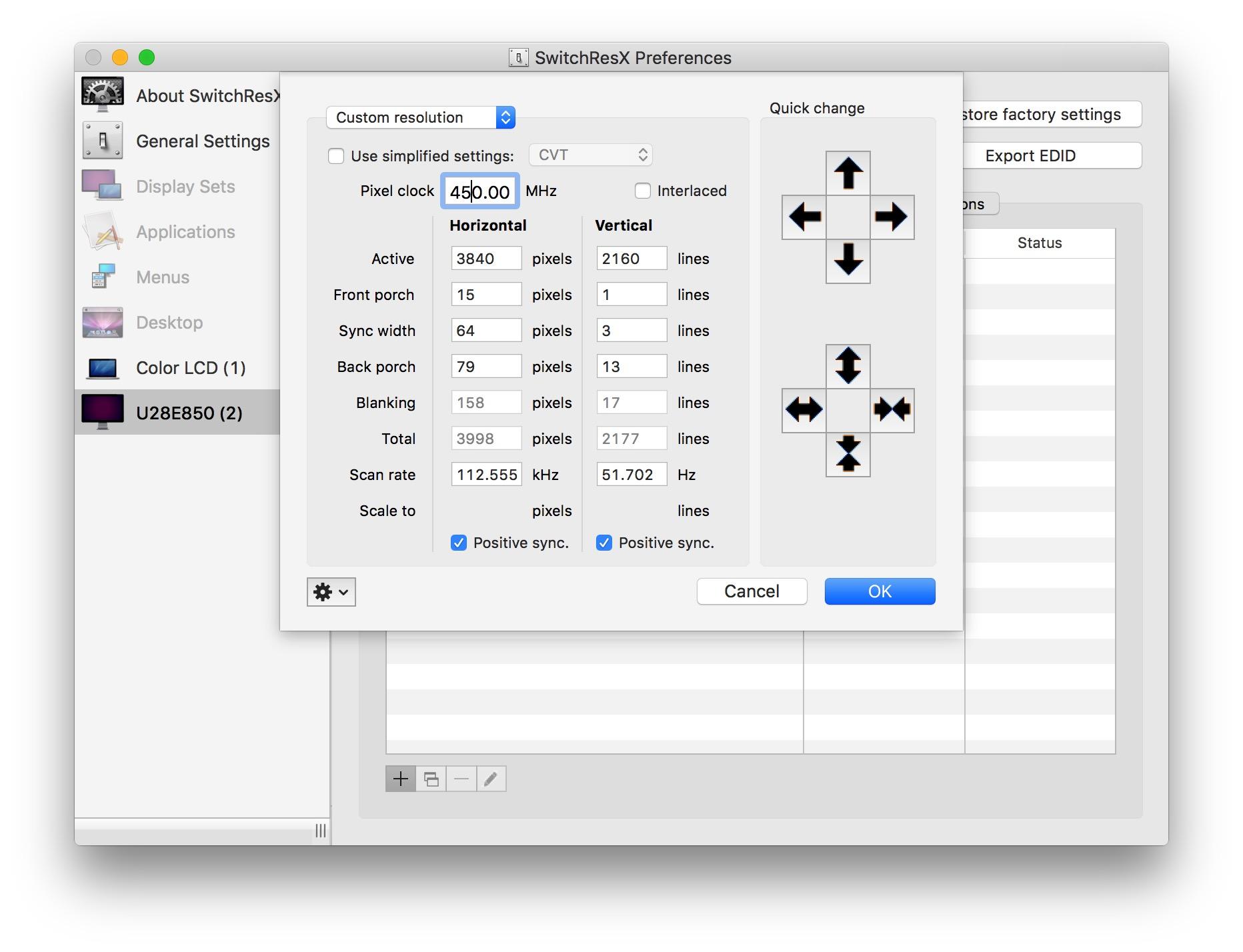
- Switchresx 4k mac os#
- Switchresx 4k drivers#
- Switchresx 4k update#
- Switchresx 4k driver#
- Switchresx 4k Patch#
Switchresx 4k drivers#
SwitchResX is used to create custom resolutions that the drivers do not automatically create.Ĭustom resolutions created in SwitchResX are validated by the graphics drivers which may choose to disable any created custom resolutions based on the reported (or assumed) capabilities of the display, the DisplayPort adapter, and the graphics hardware.
Switchresx 4k update#
Please let us know if you’d like to try a firmware update or let us know the results with SwitchResX and we will go from there.Īpple’s drivers should create resolutions depending on the reported (or assumed) capabilities of the display, the DisplayPort adapter, and the graphics hardware. Unfortunately, other than applying a firmware update or test using SwitchResX, there is not much else we can suggest to try on the Mac side of things. Seeing as you have BootCamp access, we can certainly provide steps to preform a firmware update within Windows and then test within macOS to see if the firmware helps in achieving a resolution.Ī workaround that has worked for some customers is to use a 3rd party application called SwitchResX ( ) in order to “unlock” that resolution or set a custom resolution, but we have had a mixed bag of results with this application too.
Switchresx 4k mac os#
Hi Nik, thanks for posting! We have recently discovered these issues with our adapters when running on Mac OS X/macOS where they are unable to display 4K resolutions at 60Hz, as we do not have the older MacBook Pros and Mac Pros in our labs to test. If they are not in sync, then an adapter would need to capture an entire screen’s worth of data. If they are in sync, then an adapter would need to only capture a line or two of data at a time. The DisplayPort chip will happily transmit the 2 streams of MST having similar bandwidth to one stream of SST.Īs for how difficult would it be to make an HDM 2.0 adapter that can take as input two streams of DisplayPort MST signal, I guess that depends on what kind of synchronization there is between the two streams. To answer my question of why a port that can do 60 Hz via MST can’t do the same using SST, some people suggested that a graphics chip might be able to generate 2 streams of 262 MHz but not one stream of 533 MHz of graphics data depending on the graphics core clock which could be limited on laptops to save power. Otherwise you have to override the information from the EDID if you want to change the colorspace. Apple should add a setting for switching between RGB and YCbCr in the system preferences UI. Actually, RGB and YCbCr 4:4:4 probably don’t work at more than 8 bits per component for 4K 60 Hz. Don’t try billions of colors (10 or 12 bits per component - not sure which) until you know millions works. In Mac OS X, the screen should be set to display millions of colors (I think this means RGB 8 bits per pixel but I’m not sure it couldn’t also mean one of the YCbCr formats). In that case, you’ll want to check the EDID which can be overridden in Mac OS X. There may be other issues affecting this though (not likely) such as color space and pixel depth/format (RGB, YCbCr 4:4:4/4:2:2/4:2:0, 8/10/12 bits per component).
Switchresx 4k Patch#
The patch should eliminate that incorrect logic.

Switchresx 4k driver#
Maybe Apple’s driver is getting some information from the adapter or the 4K HDMI display that makes it choose to only allow 30 Hz. It also means that that MacBook Pro should be able to give the mdp-hdmi adapter a SST 4K 60 Hz signal. If the U28D590D works with your MacBook Pro (Retina, 15-inch, Late 2013) at 4K 60 Hz, then it means that that MacBook Pro supports SST 4K 60 Hz and Apple’s HT206587 document is wrong. I also found this next link which emphasizes the single screen (not using MST) feature: I would like to know why a port that can do 60 Hz via MST can’t do the same using SST? Also, how difficult would it be to make an HDM 2.0 adapter that can take as input a DisplayPort MST signal?įound this link which says the U28D590D is SST: I guess the mdp-hdmi adapter requires SST? Are the DP monitors you’ve tried set to MST? The Apple document at says that the MacBook Pro (Retina, 15-inch, Late 2013) is supposed to be able to do 4K at 60 Hz using MST. The 15 inch MacBook Pro Late 2013 has Thunderbolt 2 ports which are supposed to support DisplayPort 1.2.


Maybe the patch can fix this case, or maybe a different patch could be made… 4K at 60 Hz requires 533 MHz which may be beyond the capabilities of the port. The patch I linked was originally for removing a 165 MHz pixel clock limit for HDMI to allow resolutions higher than 2K at 60 Hz. It could be that the Windows graphics driver has the same incorrect limitation as the Mac graphics driver or maybe the port just doesn’t support 4K at 60 Hz.


 0 kommentar(er)
0 kommentar(er)
